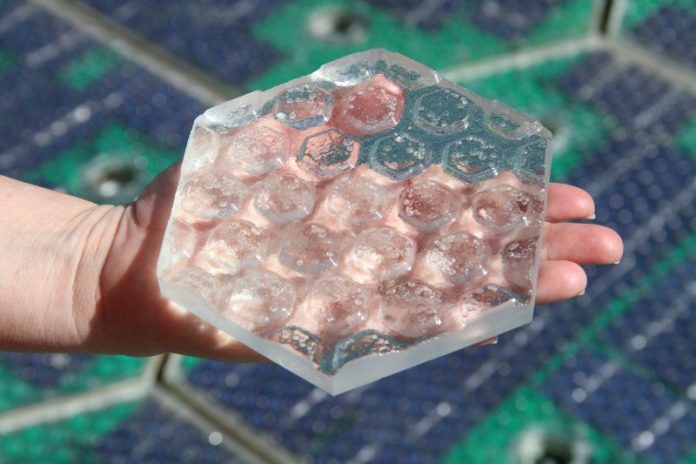
Route 66, the nearly 2500-mile historic highway that runs from Los Angeles to Chicago, will soon become the first solar roadway in the United States.
Sections of the famous highway, also known as the Main Street of America or the Mother Road, are set to be paved by hi-tech interactive solar panels (made of specifically formulated tempered glass) that contain LED lights, heating elements, and microprocessors.
As part of its Road to Tomorrow initiative, aimed at addressing future transportation and funding, the smart makeover of Route 66 comes as a result of a partnership between the Missouri Department of Transportation (MoDOT) and Idaho-based smart energy startup Solar Roadways. The first Solar Roadways panels are expected to be installed at the Historic Route 66 Welcome Center in Conway, before the end of the year.
Tom Blair, head of MoDOT’s Road to Tomorrow initiative, feels the pilot project will get Missouri and MoDOT prepared for 21st century innovations, as well as rebuild the oldest part of the interstate system.
“Solar roadways can hopefully create new revenue streams. If their version of the future is realistic, if we can make that happen, then roadways can begin paying for themselves. The project could generate a lot of interest by bringing “the history and the future together”. We are going to go out there publicly and on the Internet and ask for money to make our solar roadway pilot project even bigger and better.”
Ready world? The first public
Solar Roadways installation is coming this month. Stay tuned for dates. pic.twitter.com/NSdEWgcOlW— Solar Roadways (@SolarRoadways) September 2, 2016
Solar Roadways aims to turn existing roads into solar-powered ones, using specially engineered solar panels that can be walked and driven upon. The mission is to modernize the infrastructure with modular, intelligent panels, while producing clean renewable energy for homes and businesses.
“Our panels contain LED lights to create lines and signage without paint. They contain heating elements to prevent snow and ice accumulation. The panels have microprocessors, which makes them intelligent. This allows the panels to communicate with each other, a central control station, and vehicles [and warn drivers of upcoming traffic or impediments through LED lights]. We’ll be able to charge electric vehicles with clean energy from the sun, first on our solar parking lots, and when we have enough highway infrastructures, while driving.”
In recent months, Route 66 has seen a growing number of electric car charging stations; some states are even pushing for solar panels and electric buses. In Illinois, where Route 66 begins, a network of electric vehicle charging station has been installed from Lake Michigan to the Mississippi River.
Are Solar-Powered Highways Feasible?
Solar Roadways asserts that their solar panels are better and more durable than concrete or asphalt; that neither of those materials provides free energy; and that their solar-powered roads would deliver three times the country’s electricity demands.
However, it’s been estimated that paving the nation’s roads with solar panels would cost about $56 trillion [the cost of the hexagonal panels is estimated at about $70 per square foot, which is about 10 times the price of regular asphalt]; and once initial costs have been met, writes The Verge, there’s the issue of maintenance. Joel Anderson observes:
“There’s currently a virtually endless supply of places you could install solar panels that DON’T have cars driving over them and, as such, don’t require fancy high-tech glass covering them. Or, for that matter, don’t mean you have to worry about the long-term wear-and-tear of millions of tons of steel and rubber driving over them at high speed every year.”
In 2014, the first solar roadway opened in Netherlands’s capital Amsterdam — a 70-meter stretch of bike path made of solar panels — and it yielded positive results. Although the project was experiential and thus a little expensive, the energy output not only exceeded initial expectations, it opened doors for further development of new solar technologies. The California Department of Transportation (Caltrans) is currently exploring the possibility of a solar bike path in the United States, based on the technology used in the Netherlands.
America’s first #solar #roadway is an iconic one: https://t.co/nTBPveALql #Route66 pic.twitter.com/MbYiziWx1q
— Autodesk (@autodesk) July 19, 2016
This article (2500-Mile Route 66 — From LA to Chicago — Set to be America’s First Solar Roadway) is a free and open source. You have permission to republish this article under a Creative Commons license with attribution to the author and AnonHQ.com.





Ridiculous waste.
It isn’t waste, you’re incredibly dense.
If you’re going to pave over land that could be utilized for better things, you may as well use it to generate energy, pay for itself, heat itself up when icy. Oh, I guess you’re one of those that just loves using eighteen-hundreds technology until it destroys the whole world, aren’t you?
What’s wasteful are all of the wars, Life-engineering for company profit, revolving door insider trading crooks who pocket all of the money that is suppose to be appropriated for such uses. If the crooks in the U.S. didn’t rob it blind, we’d have more than enough currency and resources to do such projects. It is because of the older generations failure to evolve their mindset and themselves that we have old technology still wasting the world away without actually providing any great benefit, only profits to the select few who did nothing but age and profit from ruining everyone’s life.
Imagine how great the so-called “future” could be if it wasn’t arbitrarily controlled by old fools for their own gain, who prevent advances in technology only to suit themselves? I believe in improving the world as a whole, regardless of all of the nonsense and it is really hard to do that when you have the minority of the worlds population trying to control and own everything even though they couldn’t even run a hot dog stand on a corner in NY profitably.